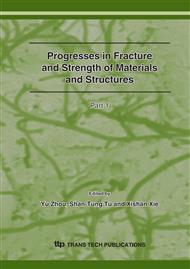p.1195
p.1199
p.1203
p.1207
p.1211
p.1215
p.1219
p.1225
p.1229
Estimation of the Elastic-Plastic Fracture Behavior of Fiber Reinforced MMC According to the Change of Interfacial Characteristics
Abstract:
Fiber reinforced metal matrix composites (MMCs) are recently used in automobile, ship, aerospace and manufacturing industry because they have high stiffness and strength. The effective utilization of the strength and stiffness of the fiber reinforced MMCs depends on efficient load transfers from the matrix to fibers through the interfacial region. However, during the fabrication and afterward utilization of composites, so many numbers of micro crack may extend, especially at the interface, even before any load has been applied. Thus, in this study, the interfacial stress state and behavior of the interfacial perpendicular crack for transversely loaded unidirectional fiber reinforced MMCs investigated by using the elastic-plastic finite element analysis.
Info:
Periodical:
Pages:
1211-1214
Citation:
Online since:
September 2007
Authors:
Price:
Сopyright:
© 2007 Trans Tech Publications Ltd. All Rights Reserved
Share:
Citation:


